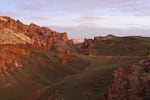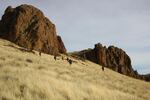
The towering red rock canyons of the Owyhee region in southeast Oregon are pictured in a 2015 file photo.
Amanda Peacher / OPB
The United States Air Force wants to open more of the Owyhee region — a vast, rugged landscape where Oregon, Idaho and Nevada meet — to low-altitude flight training.
The military branch has proposed changing airspace rules to allow flights near the speed of sound as low as 100 feet off the ground. The plan would also permit supersonic flights down to 5,000 feet above ground level.
It’s just the latest attempt by the Air Force to expand its operation in the Owyhee. The branch has for decades eyed the sparsely populated region for training bombers and fighter pilots in mountainous terrain.
The military is drawn to remote places like the Owyhee for training grounds because, in theory, they’re less likely to encounter disturbances. Critics of the proposed expansion say that isolation is precisely why the Owyhee deserves protection.
Friends of the Owyhee is a conservation and stewardship group working toward continued protection of the region.
“The Owyhee is such a special area,” said Tim Davis, founder and executive director of Friends of the Owyhee. “[Planes] flying this low … that’s going to impact the solitude of the Owyhee right off the bat.”
Related: A river journey through the geologic wonderland of the Owyhee Canyonlands
The Owyhee is one of Oregon’s lesser-known treasures. Rivers and creeks carve through a spectacular geologic layer cake formed by millions of years of volcanic eruptions. Few roads run through this territory, which makes it difficult to access.
The Mountain Home Air Force Base is located to the north. It uses airspace divided into six sections called “military operations areas” to train pilots on a variety of combat maneuvers and tactics. The airspace covers the tri-state area as well as the Fort McDermitt and Duck Valley Indian reservations.
In 1989, an Air Force proposal to build an enormous bombing range thrust the Owyhee into the national spotlight. The branch sought nearly 1.5 million acres on which to train with live munitions and to allow low-altitude flights, as in the current proposal.
The plan met a buzzsaw of opposition from ranchers, recreationists, environmental groups, Native American tribes and more concerned over impacts to communities, livestock, wildlife and recreation.
“We cattlemen support a strong national defense,” Bert Brackett, then president of the Idaho Cattle Association and later a state senator, told The Washington Post in 1990. “If there’s definitely a national security need, then we’ll sacrifice and do our part. But at this point, we’re not convinced.”
The dispute was settled in 1999, and now low-altitude training is only allowed in two sections of Idaho’s southwest corner, known as Owyhee North and Jarbidge North.
In a draft environmental impact statement published in July, the Air Force said the current arrangement “does not allow pilots to train as they would fight.”
It’s proposed opening up the remaining four sections of the airspace in Oregon and Nevada for low-altitude training.

Giant red rock formations protrude from grassy, rolling hills. Although the Owyhee is known for its canyons, the majority of the land mass in the area is high desert sagebrush country.
Amanda Peacher / OPB
The impact statement says expanding the range for low-altitude flights would increase noise, sonic booms and emissions. The Air Force acknowledges the changes would have a “moderate to high” impact on recreation in the Owyhee and create “potential for disproportionately high and adverse impacts to minority and low-income populations” in north-central Nevada and the Fort McDermitt Indian Reservation.
The impact statement also claims that wildlife with limited previous exposure to sonic booms and other noise will get used to it.
The Air Force declined an interview for this story, but said in an emailed statement that adjustments to the airspace would provide “a more realistic and consistent training environment without artificial constraints.”
“This is essential to maintain superiority over potential adversaries and to ensure the survivability and effectiveness of aircrews,” the statement reads.
Related: What's next for the Owyhee Canyonlands?
Since 1989, the Owyhee has been proposed as a national park or monument multiple times. While those efforts failed, thousands of acres have been designated as wilderness or wilderness study areas and several stretches of river as wild and scenic.
In 2019, Sen. Ron Wyden, D-Ore., introduced legislation to establish more than 1.1 million acres of wilderness in the Owyhee. The bill failed to make it out of committee but could be reintroduced in the current Congress. Several stakeholder groups, including Friends of the Owyhee, helped craft the legislation.
“Efforts for protection have been going for a long time in this area,” Davis said. “With the Air Force wanting to just use this because, ‘Oh nobody’s there,’ well, that’s what makes it special and warrants some of the protection.”
The Air Force is accepting comments on the draft environmental impact statement online and by mail until Aug. 23. The branch held two public hearings in Idaho, one on the Duck Valley Indian Reservation and one virtual.
The Air Force has not held hearings in Oregon or Nevada, where it plans to introduce low-altitude training. No additional public hearings are scheduled.
Correction: This story has been updated to indicate the correct deadline to submit public comment. The deadline is Aug. 23.


